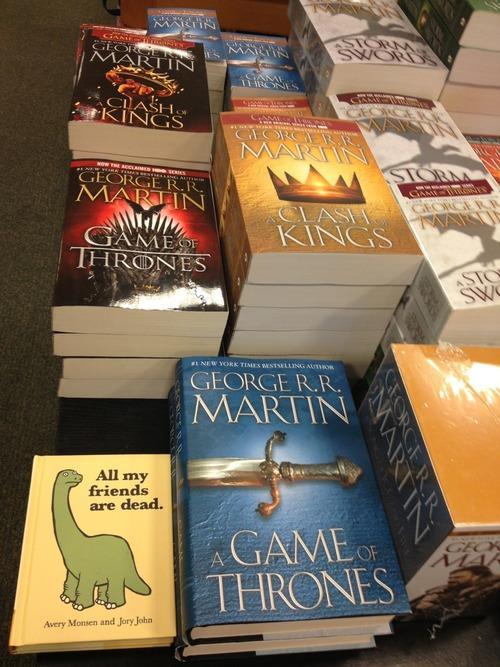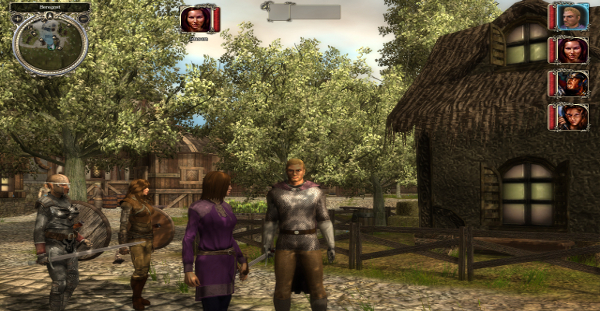It’s no secret there’s a not-so-subtle undertone of colonialism in a lot of games, particularly in strategy games. Eador: Masters of the Broken World has the player reorganize the universe into its “proper” state by conquering every available territory in the game (Filipowich, Mark. “Eador: Masters of the Broken World review.” PopMatters. May 15 2013); Civilization privileges western history, where “the United States is made the ultimate inheritor of all…human advancement and elevated to the position of the most perfect and most ‘civilized’ state of all.” (Poblocki, Kacper. “Becoming-State: The bio-cultural imperialism of Sid Meier’s Civilization.” Focaal – European Journal of Anthropology. 39. 2002: 163-177.); Age of Empires celebrates the age of—er, well—empire building. These games are founded on the assumption that history is composed of distinct, easily distinguishable peoples that emerge at the same time and under the same circumstances. The objective is to represent a group in its ascension of Eurocentric progress.
What follows is a player’s attempt to enact the imperial mythology: map every acre, subjugate every rival by the most convenient means available and acquire every resource in the name of progress. Most games, however, do this beneath a layer of fantasy, or at least with the innocent veneer of a history lesson. Expeditions Conquistador on the other hand, is not accidentally colonialist; it is a colonialist fantasy. It is a game that puts the player, with their modern, post-colonial attitudes and understandings, in the role of the first military foray into Mexico. The game argues that there is no form of colonisation that does not cause harm. All the post-colonial wisdom the player may have cannot prevent the damage of imperial expansion: it preys on the player arrogant enough to think they can “fix” history.

The cover art for Expeditions Conquistador portraying a Spanish man with a black beard and curled moustache gazing at something out of frame. Beneath, the game’s title sandwiches a simple longsword
The game begins with the promise that you, the player, can rewrite the colonisation of South America. As the opening text explains, “The year is 1518—a year before Hernán Cortés would be elected captain of the third expedition to the South American mainland, where he would overthrow the Aztec empire.” Cortés, however, never makes it to South America in this alternate history because the player-character is sent instead. The central question the game asks is what you would do, knowing what you do, if you were in Cortés’ place?
The game’s expedition takes place in a fantasy version of history. In this world women are equals in military and diplomatic roles, the purpose of the expedition is not outright conquest, just exploration and scholarly investigation of a newly discovered land. Expeditions Conquistador does not pretend it exists in a world where South America’s indigenous people were not massacred. The point of it, as a thought experiment, is to see how the player will halt Spain’s advance into Mesoamerica. The player, sitting at their computer five centuries into the colonisation of the Americas, ought to have all the knowledge they need to prevent the violence associated with Spain’s occupation of Mexico and the Caribbean. But nearly every decision in the game tempts a colonial impulse; it invites and appeals to the same imperial, “I know better than they do” arrogance that led to such violence in the first place.
For one, the option of just not colonising is unavailable. The hornet’s nest has already been kicked by the time the player arrives in Santo Domingo; the game begins after Hispaniola has been settled and after the first Spanish towns and fortresses have been built in what would come to be called the Dominican Republic. A generation of European settlers have already fought, diseased and enslaved local populations for decades. The player has no option but to reverse an established momentum. Moreover, the game seems to especially want the player to put themselves in the role.
Granted, many unnamed protagonists seem to expect the player’s name to fill the blank, but Expeditions Conquistador is particularly interested in the player’s personal investment. The main character’s profile picture is affectively neutral, betraying only their sex as chosen by the player. Next, the player composes their party based on the brief but interesting backstories and personalities of their house soldiery and staff. Each expedition member’s morale will rise or fall based on the player’s interactions in the game, the goal being to avoid a mutiny by keeping the team content and loyal. The point is to build a team of like-minded individuals to accomplish whatever the player expects to be able accomplish: either the subjugation or the salvation of the native South Americans.

Portraits of the various Spaniards available to begin the game with. 8 are women, 7 are men.
While maintaining team morale is an effective and a more nuanced twist on the “morality meter” mechanic, it’s not very difficult to compose a team whose members are of a similar enough disposition that they will stay in line. The point is that the player becomes invested in their squad: they’re trying create the perfect dream team that will fix history. After the expedition begins, though, every decision the player makes is undercut by the fact that they are colonial forces and that they will cause harm. There are decisions that cause less harm than others, but the game inevitably reduces the player’s intervention as an irresponsible, military endeavour.
The first decision the player must make is whether or not to own slaves or enlist paid servants. The player may choose not to endorse slavery and condemn the people that do, but their employment and survival still depends on slave-owners. Furthermore, the first chapter of the game positions the player opposite two factions of Spanish rebels, both abolitionists. The player can—and undoubtedly does—know that slavery and colonial occupation are wrong, but their first major rivals are people that claim to oppose European oppression. The player is never given the chance to side with either faction of the rebellion. In fact, ultimately neither faction is interested in relieving any oppressed people, one is motivated by self-interest the other by short-sighted, uninhibited rage. No matter what the player’s personal view of Spanish occupation, they must violently uphold the status quo. Moreover, the only people that are fighting against the status quo are self-interested or even more irresponsible than the current regime. This foreshadows that the player will—regardless of their intent—become a force of colonialism.
The player must uphold European occupation by virtue of their participation in it. The game tells them to fix history while acting it out. When the player reaches the mainland, they are free to explore the land and interact with the natives. For a long while the game permits (even encourages) nonviolent interactions with various tribes. But eventually, the player learns that the Totonac are conspiring with the Tlaxcaltec to overthrow the Aztec. The player can meet and speak with each side of the conflict as well as with any groups around it. But it becomes increasingly evident that both the Totonac and the Aztec want to secure the player’s loyalty against the other. The quests that each assign the player begin as harmless (track down these bandits, recover this lost artifact, safely escort this noble to that location). But the player gradually gets folded into the war, until they must choose between poisoning a Totonac city’s water supply or razing Aztec farmland. In either case, the player must make a decisive, deceitful strike against one side or the other, targeted at the labouring class with no stake in the war.

A battle from Expeditions Conquistador. Player controlled units on blue hexes line up against AI controlled enemies on red hexes.
Granted, the player may choose not to join either, the player’s ship is ready to sail back to Spain at any time in the game. However, Spain’s King Carlos will only deem the expedition a success if the player has made some great accomplishment or if they’ve acquired a great deal of wealth. Hernán Cortés waits in line just behind the player: if the player doesn’t find some resolution to the Totonac rebellion and if they don’t steal enough valuables to placate their king’s greed, than they are dooming the Totonac, the Aztecs and the other disparate tribes to the history the game tasks the player to fix. The player may support the Aztecs, they may support the Totonac or they may play the two off one another and conquer both (as Cortés had in history). They may not, however, make peace between them because they aren’t peacemakers: they’re warriors in a war. They can only destroy.
The player is placed in a politically tense situation with only a few scraps of information about which side is more justified. The Totonac call the Aztec oppressors and the Aztecs call the Totonac violent insurrectionists. The player is never qualified to make the value judgement of who is right but they’re still roped in to participating in the war. Violence is the player’s only means of action, if they choose not to act, the game picks away at their resources until they starve to death. This is where the game’s difficulty becomes especially meaningful.
Expeditions Conquistador is—at its higher difficulty settings—a remarkably challenging game. It should be. The whole purpose of the game is to force the player to intervene where they have no business. Surviving the higher difficulty settings not only puts the player at greater risk, it makes the option to raid nearby villages or unearth native religious sites for much needed supplies more tempting; thereby putting the indigenous people the player is trying to learn about at greater risk. A miscalculation or a misinterpreted sign results in disaster. Starvation and injury are only a mistake away and mistakes are inevitable. The constant threat of failure—even failure as a result of uncontrollable factors—makes it tempting to attack defenceless villagers for their food or to withhold medical supplies from a plague-stricken town to supply the expedition for another day. The game offers its player substantial, uncomfortable power with only their personal ethics to keep it reined in. But the game does more than make colonialist behaviour justifiable, at times it makes it downright fun.

The player controlled avatar on horseback stands at the base of a ruined Aztec pyramid. Thick greenery hides the structure from the main road.
It isn’t much of a revelation to say that it feels to collect powerups in Super Mario Bros. or rings in Sonic the Hedgehog? There’s not much feedback to either of these tiny events, just a sparkle and high pitched jingle, but there’s a primal reward response activated every time Mario gathers up a green mushroom or Sonic bounces off a spring to full speed. It just feels good. The steady chiming that comes with collecting points, the sharp scratch that comes with taking damage, the chirping of a cursor down a menu are all just little bits of feedback that emphasize a player’s agency in a game. People have an intuitive reaction to the stimuli that games present them. It just feels good to fill a map by exploring every corner or to see an experience points bar max out. It may be reptilian to find such small things so pleasing, but it’s effective. Expeditions Conquistador exploits these “gamey” reinforcements to make colonialism fun.
Filling blanks in Mexico’s map, luring an enemy into a bear trap, scoring a critical hit all feel good because the game emphasizes the flashes and chirps that come with succeeding an objective. Acquiring valuables earns the player a big green plus sign with a number next to it, a high pitched guitar strum punctuates every successfully completed quest, every combat victory is marked by a whooping cheer from the player’s soldiers. Each success is reinforced by the same signifiers. It doesn’t matter if the player was forced into combat because they failed a negotiation or if their success comes at monumental cost; it doesn’t even matter if the player’s own expedition members suffer a loss of morale, the game will treat the player like a winner for meeting the win condition. It takes cognitive effort for one to remember that they are simulating a colonial excursion. The game makes every victory initially feel good regardless of the context: the player as conquistador is constantly positively reinforced for conquest.
The game opens with the promise that the player can undo South America’s colonial history even as it places them in the role of conqueror. The player is a conquistador and conquistadors arrived in South America with the purpose of robbing and subjugating the aboriginals living there. With skill, luck and tact the player can avoid the absolute destruction of Mexico’s indigenous cultures; they can even create a situation that is inarguably better than Cortés’ legacy, but nonetheless the player must cause harm simply by being present where they don’t belong. The player must be an intervening force in a war they have no business in, they will be tempted to exploit natives to survive and there is a sense of accomplishment in colonial victories. Expeditions Conquistador posits that there is no action free from colonial influence: the oppressors may not “fix history.” They can only oppress to a lesser or a greater degree.
Finally, while Expeditions Conquistador does do some interesting things, it is still a narrative of aboriginal South Americans delivered by a small team based in Denmark. Furthermore, the as-yet-unreleased Mexican campaign played from the perspective of an Aztec eagle warrior could be an opportunity for a more nuanced look at colonialism and/or further appropriation of an oppressed culture’s story.
Expeditions Conquistador focuses centrally on the colonialism most similar strategic games bury in their subtext. It may not always approach its themes gracefully or respectfully—perhaps not even intentionally—but it does create an interesting space to approach colonial themes that many games aim to avoid. At about $20 on most digital distribution services it’s a tad pricier than most similarly sized independent games, but for its (perhaps reckless) courage for its themes it’s worth at least looking at.



 Ray Bradbury famously
Ray Bradbury famously 

 (reposted because a bunch of people asked for a rebloggable version
(reposted because a bunch of people asked for a rebloggable version



































